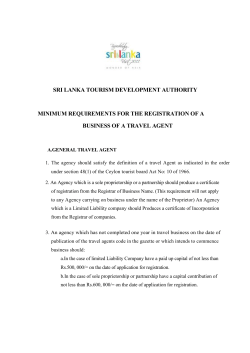
Sample OSCE stations
Sample OSCE stations At the start of the examination you will be given a booklet containing information about each of the “patients” you will see at the ten OSCE stations. The information you will be given will include the patient‟s name, age, gender, occupation and any relevant history. You will also be given a lead question. This will tell you the focus of the station. Prior to entering each OSCE station you will have up to two minutes to look at this information before you speak to the “patient”. While you are having a dialogue with the “patient”, an examiner will be marking you against a pre-agreed set of criteria on a mark sheet. Examples of candidate information and mark sheets are given below. The mark sheets are used as a basic outline and guide to the examiners. They indicate the absolute minimum required and the actual assessment of passing or failing is more complex than indicated on these mark sheets. EXAMPLE 1 Candidate information Case Topic: Discussion of possible treatment options Name Fiona Jones Age 25 years Gender Female Occupation Solicitor Relevant social history Non-smoker/never smoked Drinks 1 to 2 glasses of wine several evenings a week Relevant medical history Fit and well Information about scenario Tooth 21 traumatised at the age of 7 years; restored with a series of composite restorations, then a post crown at age 16 years. 21 root fractured approximately 1 year ago and root extracted 9 months ago. Currently wearing a tissue borne acrylic P/- to replace this tooth. Otherwise intact dentition, minimally restored. Excellent oral hygiene. At this station The patient wants to discuss with you the available options to replace the missing incisor with something more permanent. 2 Marking schedule Case Name: Fiona Jones Cand No: Case Topic: Discussion of possible treatment options Station: Examiner: Information Gathering Competent Recognises concern about aesthetics and function Appreciates relevance of the wedding in the near future and the need to move things along swiftly Also appreciates possible pressure from parents Not competent Fails to gain appropriate information Fails to appreciate influence of the forthcoming wedding Grade Dentist-patient interaction Competent Shows appropriate concern and empathy Not competent Fails to develop adequate rapport. Grade Conveying information Competent Clear explanation of various options Gives accurate information re what each procedure involves and relative costs (including time) Not competent Fails to discuss all possible options Vague Over technical explanation with lots of jargon Fails to acknowledge time constraints imposed by wedding Grade Clinical issues Competent Explains need for possible referral to „specialist‟ for implant treatment Suggests that further investigations to assess bone volume is likely Not competent Ignores possible need for additional „specialist‟ input Grade Pass/Fail (delete as applicable) 3 EXAMPLE 2 Candidate Information Case topic: History taking Name Mr Joe Bloggs Age 60 Gender Male Occupation Filing Clerk Relevant social Non-smoker, social drinker history Relevant medical Fit and well with no relevant medical history history Relevant dental Irregular attender history Information about scenario Patient has booked an appointment, informing your receptionist that he has a painful mouth. At this station Take a full history from the patient concentrating on his complaints. Then discuss his concerns and any further tests you may prescribe. 4 Marking Schedule Case Name: Joe Bloggs Case Topic: History taking Cand No: Examiner: Station: Information Gathering Competent Listens to history and elicits relevant points Asks relevant questions o Symptoms - How long, where, type of pain, initiating/relieving factors, any other treatment provided Not competent Does not obtain most of history Fails to ask relevant questions for pain diagnosis Grade Dentist/patient interaction Competent Clear, logical approach to questioning Uses appropriate eye contact & body language Professional, empathetic approach Not competent Takes history in unstructured way Fails to develop adequate rapport Unsympathetic approach Grade Conveying information Competent Clear explanation of possible diagnoses Reassures patient Avoids jargon Not competent Failure to explain causes of symptoms, reassure. Failure to reassure patient about condition Use of unnecessary jargon Grade Clinical issues Competent Explains possible further investigations Appreciates significance of history Not competent Poor understanding of significance of history Does not explain possible further tests to support / disprove differential diagnosis Grade Pass / Fail (delete as applicable) 5 EXAMPLE 3 Candidate information Case Topic: Planning treatment Name David Smith Age 20 Gender Male Occupation Student Relevant Medical Fit and well, Tetanus immunisation up-to-date History Relevant Dental History Regular attender – no restorations Information about scenario Imagine you are a dentist in general dental practice. anterior teeth while playing football yesterday. David had trauma to his upper The upper right central incisor was avulsed (knocked out). The coach found the tooth on the ground, rinsed it with water and pushed it back into the socket. On examination the tooth appears well positioned. The adjacent and opposing teeth appear intact. incisors exhibit Grade I mobility. Both the upper right and left central Radiographs of the upper and lower anterior teeth show no root fracture or other pathology. At this station The patient wishes to know if he requires any further treatment. He is concerned about the prognosis for his front teeth. 6 Marking Schedule Case Name: David Smith Case Topic: Planning treatment Cand No: Examiner: Station: Information Gathering Competent Confirms history Realises patient wishes to retain incisors Not competent Fails to recognise nature of injury Fails to establish patient‟s concerns Grade Dentist/Patient interaction Competent Shows concern and understanding Manages concerns Discusses short and long term option and effects Not competent Ignores concerns Fails to answer questions Fails to take account of patient‟s wishes Grade Communicating Competent Clear language no jargon Clear explanation of treatment – immediate and long term Clear explanation of prognosis Not competent Fails to discuss prognosis Fails to explain treatment clearly and discuss follow-up Uses jargon Grade Clinical Issues Competent Appropriate management of situation discussed Discusses prognosis Discusses outcomes and restorative options Not competent Incorrect treatment Ignores possible loss of tooth Grade Pass / Fail (delete as applicable) 7
© Copyright 2025













